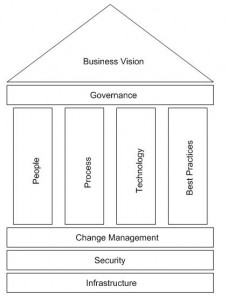From the early IBM system journal article in 1982, which defined “enterprise architecture” there have been many enterprise architecture framework evolutions such as Zachman, OpenGroup TOGAF in mid 1990’s, and lately Gartner enterprise architecture framework in 2005 defining enterprise architecture principles, enterprise architecture governance and how to establish enterprise architecture best practices. Most recently, the need for enterprise architecture is growing and more and more businesses are realizing the strategic value of enterprise architecture. Business are establishing enterprise architecture center of excellence as one of the line of practice under the Chief Information Office, setting strategic goals, priorities and business technology alignments around enterprise architecture. Let me try to put some context to these framework at a high level.
Taking a quick look at the Zachman enterprise architecture framework, it can be seen as a methodology of collecting enterprise architecture artifacts, standards and then documenting them developing an enterprise architecture taxonomy and dictionary. However, it lacks a clear picture of how you will put these together to solve the puzzle in establishing an enterprise architecture practice. Nor, it discusses the processes and structures for collecting these artifacts. The good thing is that Zachman framework tells you what artifacts that you should be collecting for starting enterprise architecture. Zachman framework compliment TOGAF ADM process guiding the requirements and artifacts and how you would arrange them to build the enterprise architecture taxonomy and process.
TOGAF however, provides step by step guide in the architecture process of establishing enterprise architecture governance through its ADM. But, in a way it guides you to collect information regarding a broader and generic architecture (Enterprise continuum, Foundation architectures and Common system architectures) before it gets into something what is practical and specific to your organization. In this process, you may spend time for doing something that you may not use it in practice.
Gartner framework discusses best practices in implementing enterprise architecture. Gartner through its consulting and research work, have been helping clients, and in the process, were able to collect lessons learned and those architecture processes that are successfully worked and deployed. The framework, however does not discuss how to implement an enterprise architecture at your organization nor it gives you any methods for taxonomy or standards.
Although all these enterprise architecture framework extensively describes and discusses about how the information architecture and artifacts should be collected and documented, there were not many standard enterprise architecture governance reference model from an organizational perspective on how you will establish an enterprise architecture practice or an organization. There are no standard organizational structure that I am aware that can help an organization structure their enterprise architecture practice.
Enterprise Architecture Governance Framework

An enterprise architecture governance framework is a high level functional hierarchy model to help your organization define the boundaries of enterprise architecture practice and how it is governed. The model will further help you to define the organizational structure, roles and responsibilities in establishing an enterprise architecture center of excellence. This governance framework will guide the architecture organization in setting up vision, guidelines and principles on which your business is aligned in the context of your business goals and its future strategic directions. Governance is a set of rules and processes of how an organization should conduct architecture processes and its activities. The governance is a level higher than a management function. In other words the management functions are framed within such rules and guidelines determined by the governance body and will have direct responsibility and accountability of an organizational behavior and action. Under this governance are core of the business i.e people, processes, technology and best practices embraced with a solid foundation of change management, infrastructure and security.
Enterprise Architecture Center of Excellence (EA COE):
Establishing enterprise architecture center of excellence is crucial to make enterprise architecture initiatives successful. Organizations need to evaluate their current hierarchy and conduct due diligence and change management processes and risk assessments. Without establishing right enterprise architecture organizational structure there is little or no governance, and without a right EA governance framework there are always greater chances of failure.
Enterprise Architecture COE is established as a strategic division under the Chief Information Office. Under the enterprise architecture, a governance body is established with key business stakeholders represented by line of businesses to set guidelines for business processes and to define business capability, functionality and change management. The architecture review board (ARB) overseas that the solution architecture meets standards and protocols, follows principles, guidelines and processes defined by the business. The chief architect is assisted by program management office for project management, shared technology services as the service delivery arm, security domain expertise and business analysts and enterprise architects for strategy and planning. The objective of this COE is to streamline the business initiatives with an architecture review board and governance body, effectively managing the strategic IT projects and application portfolio that adheres and follows the long term strategic planning of enterprise architecture vision and roadmap to align the business growth.